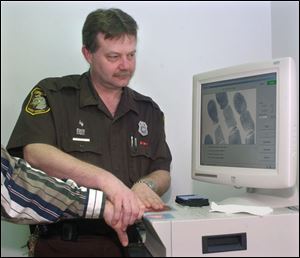
Monroe County puts its fingers on electronic identification
4/2/2004
Monroe County corrections officer Dwayne Dobbs electronically scans fingerprints into a law enforcement database.
MONROE - Monroe County sheriff's corrections officer Trish Schaffenberg doesn't much like change. But even she admits the department's new electronic fingerprint scanner, known as FingerRoll Livescan, is better than the old ink-print-and-card method.
"It's a lot quicker for us," she said this week as she prepared to handle one of the 10 to 20 customers her records department receives each day.
In 2000, the department became the first law enforcement agency in Ohio to buy an electronic print scanner to use for booking criminals, corrections officer Dwayne Dobbs said.
Since then, more than 80 percent of law enforcement agencies in Michigan and Ohio, including Lucas County, have shifted to electronic fingerprinting, said Doug Blenman, Jr., of I.D. Networks in Ashtabula, Ohio, an electronic fingerprint machine distributor.
Monroe County bought a second unit last month to handle the surge in fingerprint requests after the Sept. 11, 2001, terrorist attacks, Ms. Schaffenberg said. Applicants for all county jobs, nursing and teaching positions, and gun permits, among others, must have their prints checked.
Unlike the jail fingerprint scanner, which is connected to a state and federal database, the applicant scanner - as it's called - is not yet integrated with the state system, Mr. Dobbs said.
As a result, once prints are scanned, a printed version has to be sent to the state to see whether the applicant has a criminal history.
Mr. Dobbs said the system
will become integrated once the state figures out a payment system. Most applicants are charged $15 by the sheriff's department to have their prints taken. Additional fees could emerge once the state's integrated system is up and running, she said.
Gun permit applicants pay $150 to have their prints taken, but they have benefited from the new technology more than any other group.
Under the old system, it usually took three to four months for prints to be verified by the state. Now, it's down to 11 days and eventually will take only minutes once the system is connected to the state system, Mr. Dobbs said.
He said he doesn't miss the old ink pads. "You got [the ink] all over your uniform and body."
Contact George Tanber at:
gtanber@theblade.com
or 734-241-3610.